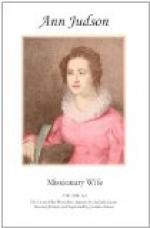The soil, in the maritime provinces, is represented as unsurpassed in fertility, and under the imperfect cultivation of the natives, yields from eighty to a hundred fold, and sometimes more.
The heights are crowned with forests, while the low lands are jungle, that is, “a region of many trees, but scattered; with much undergrowth;” and the haunt of tigers and other wild animals.
The fruit-trees are numerous, and of names and kinds unknown in America. There is found the mangosteen, with a fruit said by travellers to be the most delicious in the world; the noble mango, growing to the height of one hundred feet, and of vast diameter, and bearing as great a variety of delicious fruit as the apple-tree does with us; the cocoa-nut, whose fruit we are acquainted with, and whose husk is formed into excellent cordage; the plantain, that invaluable blessing to the natives of the torrid zone, as it supplies them bread without much labor; a circumstance of importance in countries where hard labor is oppressive by reason of heat; the splendid tamarind, with wide-spreading limbs, and a dense foliage of vivid green, among which appear clusters of beautiful yellow flowers, delicately veined with red, and the long shining pods which contain the fruit; the custard-apple, with its pulpy fruit contained in a husk resembling the pineapple in shape; and the curious palmyra, whose leaves furnish the natives with paper, while its trunk yields a liquor much prized by them as drink, and capable of being boiled down into sugar, like the juice of our maple.
Hundreds of other trees might be named, many valuable for their fruit, others for their timber, and some for both. Most of the trees are evergreen, that is, few of them shed their leaves annually and at once; but a constant succession of leaves makes the forest always verdant.
Besides the fruits which grow upon trees, there is a variety of others such as berries, tomatoes, pineapples, &c.; and among roots are found the ginger, licorice, arrow-root, sweet-potatoe, Irish potatoe, asparagus, ground-nut, &c. The country abounds in flowers of most splendid colors, but generally deficient in fragrance; though some have a fine perfume.
The favorite food of the country being rice, this is, of course, the grain most extensively cultivated. There are no farms as with us; cultivators of the soil always reside in villages, for mutual protection against wild beasts and robbers. Each family cultivates a patch of the neighboring jungle, and brings the produce into the village, where the cattle are also brought for security. Besides rice, they cultivate wheat, Indian-corn, sugar-cane, millet and indigo; but generally in a slovenly and unskilful manner. In the dry season, the land is watered by artificial means, some of which are quite ingenious.
Of animals there is, of course, a vast variety, one of the most useful of which is the buffalo, which is used to draw their carriages, as well as to perform the labor that the ox does with us. Elephants are the property of the king, but great men are allowed to keep them.




